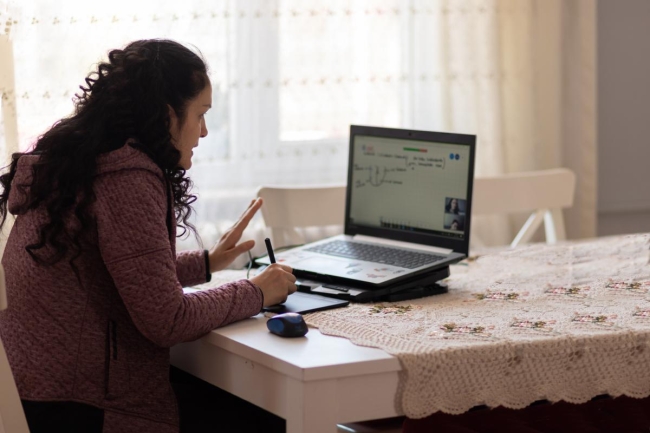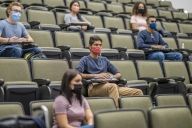You have /5 articles left.
Sign up for a free account or log in.

Phynart Studio/iStock
It was a trickle that became a deluge, as four-year colleges of all sorts began to announce their fall 2021 plans. Many took great pains to advertise a large share of in-person classes and activities, pushing as much as they could for a “return to normal.”
Now that plan -- a return to majority in-person classes -- has become the norm among four-year institutions. But many community colleges have been planning for something different. Some have announced that classes will be largely remote this fall, rejecting some of the optimism of their peers.
“As long as I have to adhere to the [Centers for Disease Control and Prevention] and [California Division of Occupational Safety and Health] guidelines, that’s not going to happen,” said Frank Chong, president of Santa Rosa Junior College, referring to opening up full-time in person.
And in California, Chong has his supporters. While Governor Gavin Newsom has said he expects every public school and college to see a full return this fall, Eloy Oakley, chancellor of the community college system, has been skeptical. If vaccine uptake is good, there could be more in-person classes, he has said, but caution is still warranted.
At Santa Rosa, Chong said, many classrooms are small. As long as the CDC maintains its guidance of six feet of social distancing, it’s not physically possible to hold classes in person with the numbers of students needed. If the guidance changes to three feet, he said, that could help.
Timing was also important in making the decision, Chong said. It would be difficult for the college to move from online to in person at the last minute.
“One thing I’ve found out during the year is even if people don’t like the decision, they like the certainty,” he said. “Faculty and students can start planning their lives and schedules.”
The reaction has indeed been mixed. One adjunct professor of art history took to the pages of The Press Democrat to call the decision misguided, explaining that many students are aching to return to in-person learning. The professor suggested that classes could fit the required number of students if they are kept only three feet apart, which the CDC has recommended for K-12 schools, but not yet colleges.
“I’m an extrovert. I desperately miss being with people, being with students, faculty and staff,” Chong said. “But as an administrator, as a college president, we have to follow the guidelines -- we can’t deviate from that.”
The college is indeed planning to open up more in-person classes, prioritizing the courses that students struggle to do well in when taking them remotely, especially in fields like health and science.
While it’s too early to tell, it appears that demand for in-person classes among community college students differs from the demand among peers at four-year institutions. While students at four-year colleges and universities have been clamoring to return to campus, it appears that some community college students have enjoyed the flexibility that remote classes have offered. Students who live far from campus, take care of children or work while going to school may prefer remote or asynchronous styles.
At Northern Essex Community College in Massachusetts, for instance, the administration has opened up registration for the fall semester, with 25 percent of courses in person. If demand is high, the college will open up more, said Lane Glenn, president of Northern Essex.
But so far it’s been two weeks, and the open courses haven’t filled.
“For those students who have discovered that online or hybrid are options that work well for their schedules, their families, their work lives, and that they can learn effectively that way, more of them may stick with it,” Glenn said. But it’s important to still open some in-person classes, he said, for those students who have not learned to like online lectures and labs. Those whom the college has lost have been mostly low-income students of color.
Community colleges are also facing the issue of vaccines. Many four-year institutions are mandating that students be fully vaccinated against COVID-19 before coming to campus. But community colleges have to make a different calculation. Students who can’t or won’t get vaccinated could be left behind by an inoculation mandate.
Both Santa Rosa and Northern Essex aren’t requiring vaccines for students. In Massachusetts, where Northern Essex is located, the state’s 15 community colleges released a letter saying they would not mandate student vaccinations unless directed to by government authorities.
“We feel that we can make our campus environments safe enough, and we don’t want to put an additional barrier up in front of students who need us and might not yet be comfortable with that vaccination,” Glenn said. The college lost 5 percent of its enrollment last fall and 7 percent this spring. The gap in retention between Latino students and white students nearly doubled. It is now aiming to have a 1 percent increase in enrollment for this fall.
Other colleges limiting in-person classes have emphasized the importance of keeping students and employees safe. Palomar College in California is looking at holding approximately 30 percent of courses in person in the fall, although no firm decisions have been made yet.
“Our planning for the fall semester continues to be centered around the health and safety of our students and employees,” Julie Lanthier Bandy, a spokesperson for the college, said via email. “Our primary focus is to make sure we are offering courses both onsite and online that enable our students to complete their degree and certificate programs on time.”
The College of Staten Island, a four-year college that caters to local commuters, has said it is aiming for 25 percent of classes to be in person this fall.
"However, this is subject to change as more data becomes available concerning vaccinations, daily case counts, changes in social distancing regulations and any additional guidance we may receive from the [New York Department of Health]," a spokesperson for the college, said via email. "The health and safety of our students, faculty, and staff have been the foremost considerations of the college."
The College of DuPage in Illinois is looking to slowly ramp up in-person learning. Fifteen percent of classes will be in person this summer and the number will grow to 30 percent in the fall, said President Brian Caputo.
“We’re trying to gauge our response, in terms of modes of course delivery, to what’s happening around us. So we hope it will get better. We’ll keep opening up in response to that. But at the same time, if something goes the other direction, we’re prepared to constrict again,” he said. “Everybody realizes that we’re trying to take a very measured response to the situation. Safety is paramount in our minds.”
The college is similarly not requiring vaccinations for students.
As is the case at many institutions, community college administrations are considering what their future looks like.
“Pre-pandemic, 15 percent of our classes were online. I can’t imagine that ever again dropping to below one-third,” said Glenn. “I doubt we will ever go back to the exact mix that we had pre-pandemic.”








